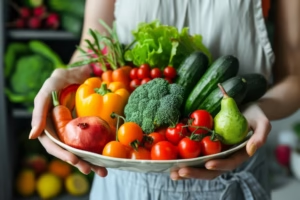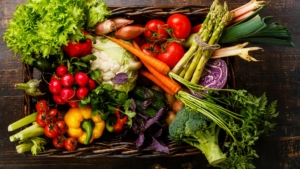Hey there, fellow dirt-lover. I remember the first time I stuck a seed in the ground—some scraggly carrot thing from a discount packet. It was more hope than plan, but that tiny green shoot popping up felt like winning the lottery. If you’re here, maybe you’re chasing that same thrill. Vegetables aren’t just side dishes; they’re nature’s quiet rebels, packing flavor and nutrition into every bite. This guide dives deep into what makes them tick, from their quirky family trees to the nitty-gritty of growing your own. Stick with me, and we’ll turn your backyard (or windowsill) into a bounty that’d make your grandparents jealous.
What Are Vegetables? A Quick Rundown
Let’s kick things off simple: Vegetables are the edible parts of plants we humans have decided to call dinner staples, not desserts. Think leaves like spinach, roots like potatoes, or even fruits masquerading as veggies (looking at you, tomato). Botanically, it’s a gray area—fruits come from flowers, veggies from anywhere else—but in the kitchen, it’s whatever tastes good roasted or steamed. They’re low-cal wonders, mostly water with a punch of vitamins A and C, plus minerals like iron that keep us humming. No wonder ancient folks started farming them 10,000 years ago; they’re survival food with style.
I once tried explaining this to my skeptical nephew over a salad— “Uncle, why not just eat candy?”—and ended up with a leaf-stuck grin when he admitted kale chips beat gummy bears. It’s that relatable magic: everyday eats with superpowers.
Types of Vegetables: Sorting the Garden Chaos
Vegetables come in all shapes, like a plant world’s family reunion where everyone’s got a different job. We group them by the part we munch—roots for crunch, leaves for green glory—which helps when planning your plot. This isn’t just nerdy classification; it guides what grows where and when, saving you from a sad, mismatched harvest. Overlap happens, sure, but starting here keeps things sane.
Root Vegetables: Underground Treasures
These bad boys store energy below soil, giving us hearty bites like carrots and beets. They’re champs in cooler weather, pulling double duty as snacks or soups. Plant them deep in loose dirt, and they’ll reward you with sweetness that store-bought can’t touch.
My first beet haul? Muddy orbs that stained my hands pink for days. But roasted with goat cheese? Pure poetry—and a story for every dinner party.
Leafy Greens: Fresh and Feisty
Lettuce, kale, spinach—these are the salad stars, quick to grow and harvestable in waves. They thrive in partial shade, loving moist soil without fuss. Nutrient powerhouses, they’re vitamin K on steroids, but watch for bolting in heat.
Stem and Stalk Vegetables: The Structural Eats
Celery, asparagus—tough on the outside, tender inside. They need space to stretch, often taking longer to mature. Stakes or trenches help, turning potential flops into crunchy triumphs.
Fruit Vegetables: Sneaky Botanicals
Tomatoes, peppers, zucchini—technically fruits, but we veggie-fy them for savory vibes. Warmth lovers, they fruit like crazy in sun-soaked spots. Pollination woes? A gentle bee nudge (or your finger) fixes that.
Flower and Seed Vegetables: Buds and Beans
Broccoli florets, peas in pods—these bloom or burst with goodness. Cool for flowers, warm for seeds; they’re versatile but picky about timing to avoid bitterness.
Popular Vegetable Examples: Stars of the Plate and Patch
Nothing beats biting into a sun-ripened tomato, juice dripping like summer’s last hurrah. Examples like carrots (beta-carotene bombs) or broccoli (that tree-like crunch) show veggies’ range—from humble potatoes feeding empires to exotic okra starring in gumbos. Each has a backstory: potatoes fled Ireland’s famine, kale shrugged off Black Death myths. Pick ones that match your taste and turf; start small to avoid overwhelm.
Last summer, my zucchini exploded—literally, one plant fed the block. We joked it was auditioning for a horror flick, but those grilled slices? Neighborhood peacekeepers.
Vegetable Farming Basics: Dirt to Dinner
Farming veggies is less mad science, more patient dance with seasons. From picking a sunny spot to battling bugs, it’s hands-on magic that yields fresher-than-fresh eats. Beginners, fear not: start with a 4×4 bed, and scale as confidence blooms. It’s forgiving—most mistakes just mean next year’s redo.
Site Selection: Where the Magic Happens
Sunshine’s your MVP: six to eight hours daily, plus well-drained soil that doesn’t drown roots. Test pH (aim 6-7); low spots invite rot. Flat or gently sloped? Ideal for even watering.
Soil Prep: Building the Foundation
Loamy, fertile soil is veggie gold—think crumbly cake, not concrete. Amend with compost; till lightly to wake microbes without wrecking structure. Raised beds dodge poor native dirt, warming faster for early starts.
I skipped this once—planted in clay—and pulled twisty carrots like modern art. Lesson learned: happy soil, happy harvest.
Planting Techniques: Seeds vs. Starts
Direct sow cool crops like peas; transplant heat-lovers like peppers. Space per tag—crowding invites drama. Mulch early to smother weeds.
Watering and Nutrients: Quench and Feed
Deep, infrequent soaks mimic rain; aim finger-wet soil. Fertilize balanced—nitrogen for greens, phosphorus for fruits. Drip lines save sanity.
Pest and Disease Management: Guardians of the Green
Slugs? Beer traps. Aphids? Ladybugs. Rotate crops yearly to baffle foes; neem oil’s a gentle warrior. Organic focus builds resilience.
Best Tools for Vegetable Farming: Gear Up Without Breaking the Bank
Tools turn grunt work into glee—think wheel hoe for weeding marathons, not backaches. For beginners, prioritize versatile picks like a sturdy spade or flame weeder for no-chem kills. Invest wisely; quality beats quantity.
- Digging Fork: Loosens soil sans slicing worms—my go-to for turning beds.
- Wheel Hoe: Glides through rows, slicing weeds like butter.
- Pruners: Clean cuts for harvest; bypass style for precision.
- Garden Rake: Levels seedbeds smooth as silk.
- Flame Weeder: Torches tiny invaders—eco and efficient.
Pros of investing: Faster chores, bigger yields. Cons: Upfront cost, but they pay off in saved time.
| Tool | Best For | Price Range | Why Beginners Love It |
|---|---|---|---|
| Digging Fork | Soil turning | $20-50 | Gentle on earthworms |
| Wheel Hoe | Weeding rows | $150-300 | Saves your back |
| Pruners | Harvesting | $15-40 | Sharp as a chef’s knife |
| Rake | Bed prep | $10-30 | Quick and lightweight |
| Drip Irrigation Kit | Watering | $20-100 | Set-it-forget-it ease |
Where to snag ’em? Home Depot for basics, Johnny’s Selected Seeds for pro-grade.
Comparison: Organic vs. Conventional Vegetable Farming
Organic whispers to the soil—compost, cover crops, biodiversity—yielding veggies with deeper flavors but slower ramps. Conventional leans on synthetics for speed and scale, cranking volume but risking runoff blues. Which wins? Depends on your plot size and ethos.
| Aspect | Organic | Conventional |
|---|---|---|
| Soil Health | Builds long-term fertility | Quick boosts, potential depletion |
| Pest Control | Natural predators, rotations | Chemicals—fast but monitored |
| Yield | Steady, flavorful | Higher initial, uniform |
| Cost | Higher labor, lower inputs | Cheaper upfront, more chems |
| Eco Impact | Low—biodiverse havens | Higher—watch for pollution |
Organic pros: Tastier, planet-friendly. Cons: Steeper learning curve. Conventional pros: Beginner-proof scale. Cons: Chemical creep.
I went organic after a chem-spray scare; now my kale’s bug-proof and guilt-free.
Pros and Cons of Home Vegetable Farming
Growing your own? It’s therapy with tangible wins—fresher food, slashed grocery bills. But weeds don’t vacation, and rabbits crash parties.
Pros:
- Ultra-fresh nutrition—harvest at peak ripeness.
- Cost savings: $1 seed packet feeds a family.
- Mental boost: Stress melts in the mud.
- Customization: Rare heirlooms galore.
Cons:
- Time sink: Daily checks through dry spells.
- Space hogs: Vines wander if unchecked.
- Learning lumps: First-year flops build grit.
- Weather whims: Hail’s a heartbreak.
Through it all, that first homegrown salad? Worth every thorn prick.
Vegetable Farming Tips for Beginners: From Seed to Success
New to this? Ease in with forgiving crops like radishes—30 days to munch. Plan via almanac calendars; succession sow for steady supply. Journal fails and wins; it’ll sharpen your green thumb fast.
Emotional nudge: My rookie plot drowned in July rains, but those survivor tomatoes tasted like victory. Yours will too—patience is the secret sauce.
Where to get seeds? Seed Savers Exchange for heirlooms, Burpee for starters. Best tools? Hoss’s wheel hoe kit crushes weeds without sweat.
People Also Ask: Real Questions from Fellow Growers
Pulled straight from Google’s whisper network, these hit common curiosities. Quick answers to keep you scrolling less, digging more.
What is the easiest vegetable to grow?
Radishes top the list—sow direct, harvest in a month. They’re forgiving, needing little beyond sun and space. No green thumb required; even apartment pots work.
Why do vegetable plants stop producing?
Heat stress, nutrient dips, or overcrowding often stall them. Pinch flowers on basils, water deeply through droughts. A quick soil refresh revives most.
How many fruits and vegetables should I eat a day?
Aim for five servings—half fruits, half veggies. A fist-sized apple counts as one; leafy greens stretch further. It’s flexible fuel for your body.
What vegetables grow well in shade?
Leafy stars like lettuce, spinach, and chard thrive with dappled light. Avoid fruiters here; they sulk without sun. Bonus: Less bolting in cool shade.
How do I control weeds in my vegetable garden?
Mulch thickly with straw—smothers sprouts without chemicals. Hoe weekly for stragglers; cardboard under paths blocks forever. Prevention beats cure every time.
FAQ: Your Burning Vegetable Questions Answered
Got queries? These crop up often in my chats with new growers. Straight talk, no fluff.
What soil is best for vegetable gardening?
Loamy, well-draining with organic matter—pH 6.0-7.0. Mix in compost yearly; test kits from extension services guide tweaks.
How often should I water my vegetable garden?
1-2 inches weekly, deeper for roots like tomatoes. Morning drips beat evenings; wilting leaves scream “thirsty!”
Can I grow vegetables in containers?
Absolutely—pots for patios! Use 5-gallon minimums with drainage; dwarf varieties shine. Refresh soil annually.
What’s the best fertilizer for vegetables?
Balanced 10-10-10 for starts, then bloom-boosters for fruiters. Organic? Worm castings rule—slow-release magic.
How do I start a vegetable garden on a budget?
Seeds over starts, recycled pots, free mulch from clippings. Borrow tools; swap with neighbors. Joy’s free anyway.
Wrapping this up feels like harvest time—bittersweet, full of promise. Veggies taught me resilience: some seasons flop, others overflow. Yours? Dive in, get muddy, and share your tales. What’s your first plant? Drop it below; let’s grow together.




